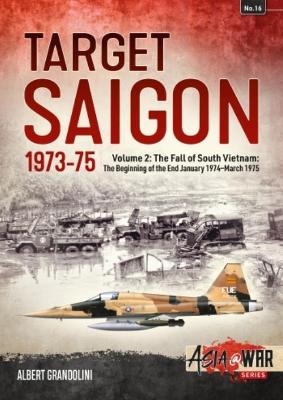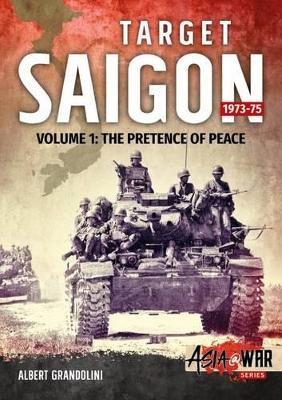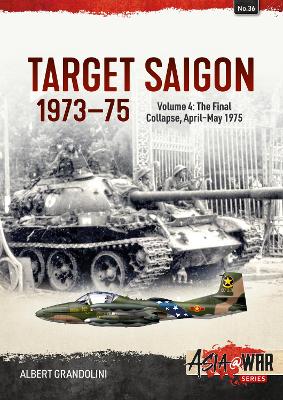Asia@War
6 total works
Drawing on a wide range of Vietnamese-language sources, the author presents a detailed account of the continuing efforts of North Vietnam to invade the South, enlivened by a large number of previously unpublished photographs, and colour profiles for modellers. A year after the Paris peace accord had been signed, on 17 January 1973, peace had not been settled in Vietnam. During that period, the North Vietnamese continued their attacks now that the United States had pulled out completely their forces, with the definitive conquest of South Vietnam as the goal. The South Vietnamese forces' erosion on the field increased in face of a series of concerted North Vietnamese offensives at Corps level. The drastic American aid reduction began to impact heavily on the South Vietnamese ability to wage war. Equally, Saigon could not respond to a Chinese invasion of the Paracel Islands after a brief naval battle, and if Hanoi had been bolstered by massive deliveries of equipment from Peking and Moscow, both the Chinese and the Soviet had withheld the delivery of sufficient ammunitions for the artillery and the tanks, to deter the North Vietnamese from attempting a new widescale offensive against the South. It was with these constraints that the North Vietnamese leadership planned their new campaign, initially expecting it to take 2 to 3 years. A last test had to be done in order to assess the American intentions in case of an all-out North Vietnamese offensive against the South - if a South Vietnamese provincial capital was taken without American reaction, then Hanoi would begin the last campaign of the war. After the fall of Phuoc Long, the North Vietnamese decided to attack the strategic Central Highlands area where they hoped to destroy the greater part of an ARVN Corps. The battle of Ban Me Thuout would be the pivotal event leading to the rapid collapse of South Vietnam. While the battle was going on, without taking advices from his generals, President Nguyen Van Thieu of South Vietnam decided to take radical measures by redeploying his forces. That meant abandoning no less than half of the country, in order to shorter his logistic communication lines and to concentrate his remaining depleted forces around Saigon and the Mekong Delta area. He probably also hoped that by aggravating the military situation he would force Washington to fulfil its promise that "in case of massive violation of the cease-fire", the Americans would resume their military aid and would send back the B-52s.
On 30 March 1972 the South Vietnamese positions along the Demilitarized Zone (DMZ) that separated the North from South Vietnam were suddenly shelled by hundreds of heavy guns and multiple rocket launchers. Caught in a series of outposts of what was the former 'McNamara Line', the shocked defenders had just enough time to emerge from their bunkers at the end of the barrage before they were attacked by regular North Vietnamese Army divisions, supported by hundreds of armoured vehicles that crashed though their defensive lines along the border. Thus began one of the fiercest campaigns of the Vietnam War but also one of the less well documented because by then most of the American ground forces had been withdrawn.
Following on from the details of the downsizing of American forces and the setting up of the'Vietnamization' policy, the build up of both the Army of the Republic of Vietnam (ARVN) in the South and the People's Army of Vietnam (PAVN) in the North is discussed at length. A special emphasis is devoted to the study of the development the North Vietnamese armoured corps that would spearhead the coming offensive. Consequently, the nature of the war changed dramatically, evolving from a guerrilla one into a conventional conflict.
The South Vietnamese resistance shuddered, and then crumbled under the communist onslaught, putting Hue the ancient imperial capital at risk. It was only thanks to US airpower, directed by a small group of courageous American advisers, which helped to turn the tide. Under the command of a new capable commander, the South Vietnamese then methodically counterattacked to retake some of the lost ground. This culminated in the ferocious street fighting for Quang Tri.
This first volume describes the combat taking place in the northern part of South Vietnam, and uses not only American archives but also Vietnamese sources, from both sides. The book contains 130 photos, five maps and 18 colour profiles.
Asia@War - following on from our highly-successful Africa@War series, Asia@War replicates the same format - concise, incisive text, rare images and high quality colour artwork providing fresh accounts of both well-known and more esoteric aspects of conflict in this part of the world since 1945.
Following on from the details of the downsizing of American forces and the setting up of the'Vietnamization' policy, the build up of both the Army of the Republic of Vietnam (ARVN) in the South and the People's Army of Vietnam (PAVN) in the North is discussed at length. A special emphasis is devoted to the study of the development the North Vietnamese armoured corps that would spearhead the coming offensive. Consequently, the nature of the war changed dramatically, evolving from a guerrilla one into a conventional conflict.
The South Vietnamese resistance shuddered, and then crumbled under the communist onslaught, putting Hue the ancient imperial capital at risk. It was only thanks to US airpower, directed by a small group of courageous American advisers, which helped to turn the tide. Under the command of a new capable commander, the South Vietnamese then methodically counterattacked to retake some of the lost ground. This culminated in the ferocious street fighting for Quang Tri.
This first volume describes the combat taking place in the northern part of South Vietnam, and uses not only American archives but also Vietnamese sources, from both sides. The book contains 130 photos, five maps and 18 colour profiles.
Asia@War - following on from our highly-successful Africa@War series, Asia@War replicates the same format - concise, incisive text, rare images and high quality colour artwork providing fresh accounts of both well-known and more esoteric aspects of conflict in this part of the world since 1945.
After 27 years of conflict it seemed that peace would finally settle on the Indochina peninsula on 27January 1973 with the signing of a peace accord in Paris. The North Vietnamese had previously launched their greatest offensive against South Vietnam but fell short of their objectives, the destruction of the Army of the Republic of Vietnam (ARVN) and the destruction of the Saigon regime. They now proposed, in exchange for the release of the US prisoners of war, the withdrawal of the remaining American forces in Vietnam. Far from feeling committed by the agreement, the Hanoi leadership prepared the next round, the ultimate conquest of South Vietnam now that Washington had completely evacuated its last troops from the country. That first volume sets the scene, by making an assessment of the situation on the field, in both tactical and strategic perspectives. It also examines the last episode of the US gradual withdrawal as well as the implementation of part of the Peace Accords with the removal by the US Navy of the mines sown by its aircraft from the North Vietnamese ports and inland waters. It then presents the respective opposing armed forces and will particularly focus on the North Vietnamese rebuilding after the havoc wrought by the American aerial campaign of 1972. Furthermore, the expansion of the famous Ho Chi Minh Trail, vital for the logistical support of the communist troops, is thoroughly detailed. The South Vietnamese on their part placed great emphasis on developing their own air force in order to try to replace the withdrawal of American airpower. Most at all, it also details the initial fighting that not only resumed but soon escalated into divisional-level battles where the South Vietnamese still prevailed.
On 30 March 1972, while peace negotiations had been dragging on for four years in Paris, the North Vietnamese launched a wide scale offensive in order to break the stalemate. At that date, practically no American ground forces remained in South Vietnam where a limited offensive was expected in the Central Highlands area. But nobody imagined the magnitude of the multi-divisional, armour led onslaught. The blow fell first across the Demilitarized Zone (DMZ) separating the North from South Vietnam (see Volume 1). Following from the initial attack, in a surprise move, three communist divisions with T-54 tanks attacked from their sanctuaries in Cambodia just north of Saigon. Their tanks ventured into the streets of An Loc City where they were checked by a desperate and heroic stand by the South Vietnamese soldiers and their American advisers, thus saving the capital of South Vietnam.
Finally, the third prong of the North Vietnamese offensive swept across the northern Central Highlands, destroying a whole South Vietnamese division. The communists then resumed their advance, but their tanks were again entangled in street fighting, this time inside Kontum City. Furthermore, they were harassed by newly developed helicopter gunships armed with anti-tank missiles. This volume not only details the combat taking place in these two areas but also the organization of both the Army of the Republic of Vietnam (ARVN) in the South and the People's Army of Vietnam (PAVN) in the North. It particularly emphasises the transformation of the former from a mainly infantry force into a modern motorized force. It also describes how the North Vietnamese learnt the hard way about the use of their tanks.
The author relies on not only American archives but also on Vietnamese sources, from both sides. The book contains 130 photos, five maps and 18 colour profiles.
Asia@War - following on from our highly-successful Africa@War series, Asia@War replicates the same format - concise, incisive text, rare images and high quality colour artwork providing fresh accounts of both well-known and more esoteric aspects of conflict in this part of the world since 1945.
Finally, the third prong of the North Vietnamese offensive swept across the northern Central Highlands, destroying a whole South Vietnamese division. The communists then resumed their advance, but their tanks were again entangled in street fighting, this time inside Kontum City. Furthermore, they were harassed by newly developed helicopter gunships armed with anti-tank missiles. This volume not only details the combat taking place in these two areas but also the organization of both the Army of the Republic of Vietnam (ARVN) in the South and the People's Army of Vietnam (PAVN) in the North. It particularly emphasises the transformation of the former from a mainly infantry force into a modern motorized force. It also describes how the North Vietnamese learnt the hard way about the use of their tanks.
The author relies on not only American archives but also on Vietnamese sources, from both sides. The book contains 130 photos, five maps and 18 colour profiles.
Asia@War - following on from our highly-successful Africa@War series, Asia@War replicates the same format - concise, incisive text, rare images and high quality colour artwork providing fresh accounts of both well-known and more esoteric aspects of conflict in this part of the world since 1945.
Nine Lives of the Flying Tiger Volume 1
by Albert Grandolini and Marc Koelich
Published 15 August 2022





